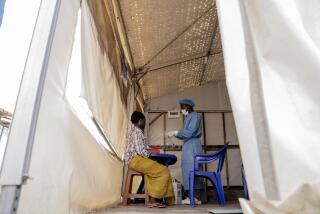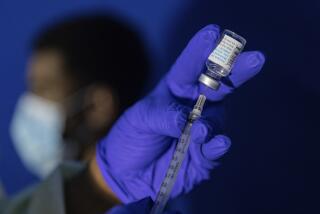Odds Favor Controlling Smallpox Attack
NEW YORK — Imaginative minds can conjure horribly apocalyptic consequences from a smallpox attack.
Here is a disease that kills 30% of those it infects and leaves survivors permanently scarred.
After plaguing humanity for centuries, it was finally eradicated three decades ago so that no one today has any built-up immunity to it. The smallpox vaccinations some people had as children would no longer be effective. Unchecked, smallpox has the potential to sweep through the United States population like the plagues of medieval Europe.
But with the help of computers, many researchers are concluding that a smallpox attack by terrorists need not produce an uncontrollable public health crisis. Computer simulations show that the proper combination of post-attack vaccination, quarantine and other public health measures could stop smallpox in its tracks:
* A model designed by researchers from the Centers for Disease Control and Prevention found that vaccination and quarantine could stop an outbreak within a year and limit the number of smallpox cases to 4,200--even if 1,000 people were directly infected by terrorists.
* Researchers from Yale University and the Massachusetts Institute of Technology found through another simulation that a massive vaccination program launched as soon as the first smallpox cases were detected could quickly stop the disease from spreading and limit infections to fewer than two times the initial number.
* By simulating the daily comings and goings of people in Portland, Ore., researchers from Los Alamos National Laboratory found that reasonable public health measures, combined with people’s natural tendency to stay home when they’re feeling sick, would likely limit the spread of smallpox after an attack.
“I think it’s apparent that we can control an outbreak of smallpox if we do the right thing,” said Stephen Eubank, a researcher in the Basic and Applied Simulation Science Group at Los Alamos.
The simulations are much like those computer games where you play the mayor of a growing city. The choices you make about zoning regulations, tax rates and other issues determine whether your city prospers or collapses into blight.
With the smallpox models, you make decisions about whom to vaccinate and quarantine. You decide what to tell the public and when. Then the computer calculates how the disease will spread through the population, illustrating how different strategies might pan out.
“No one can predict the future,” said Tara O’Toole, director of the Center for Civilian Biodefense at Johns Hopkins University. “Models can help us imagine it and maybe help us respond.”
The Los Alamos model, for example, replicates the daily life of every single person in Portland to see how trips to school, work, malls and the like would spread smallpox through the community.
Portland residents needn’t fear that Big Brother is watching--Los Alamos researchers use census data and anonymous questionnaires to generalize people’s daily comings and goings, not actual surveillance.
Eubank and his colleagues originally designed the program to help planners envision how changes in Portland’s transportation system would affect residents’ ability to move around the city. By adding a smallpox transmission model, Eubank has created a simulation of how the disease moves too.
He starts the simulation by giving a specific group of people smallpox. It could be a dozen shoppers at a particular mall or a handful of infected terrorists who set about trying to pass their illness to other people. Then he sees how the movements of those initially infected people spread the disease in the population.
Eubank can also change people’s behaviors based on how they feel. For example, he said, “when you contract smallpox, you get sick as a dog. It happens about the time you become contagious.”
The Los Alamos model simulates that by keeping many of the most contagious people home, not out infecting their friends and co-workers. In a smallpox outbreak, if authorities could convince those who felt sick to stay home--perhaps by promising a house call from an infectious disease specialist, Eubank said--many fewer people would be infected.
The surest way to prevent a smallpox attack from killing more than a handful of people would be to vaccinate the majority of the population in advance. But the protection offered by widespread vaccination would come at a serious cost.
The smallpox vaccine is one of the most dangerous ever used. It can cause life-threatening complications in people with eczema and compromised immune systems, and it kills about one person in a million. Given to the entire U.S. population, smallpox vaccine could kill nearly 300 people and permanently injure thousands more.
Models show that pre-vaccinating the public isn’t necessary, however. If there were a system in place to vaccinate everyone in a city at the first appearance of smallpox, said Edward Kaplan of Yale University, an outbreak could be stopped in a few weeks.
In the hypothetical case of a smallpox attack that initially infected 1,000 people, a model designed by Kaplan and colleagues from MIT calculated that mass vaccination would limit the number of casualties to 1,830 illnesses and 560 deaths in a city of 10 million.
Some people would suffer serious complications from the vaccinations, and about 10 would die. But in the face of a potential smallpox epidemic, Kaplan believes that the odds would almost always favor mass vaccination over a less aggressive approach.
Other strategies, such as vaccinating only the close relatives and contacts of infected people, would be superior only if the number of people infected by the initial attack were fewer than a couple dozen or if smallpox were significantly less infectious than his model assumes.
But it’s exactly that assumption, and many others, that public health officials should consider before using models to help determine their policies, said Martin I. Meltzer, an epidemiological modeler at the CDC.
“I think there’s a lot of innovative thought behind it,” Meltzer said of Kaplan’s model. “I just think there are some assumptions that we might question.”






